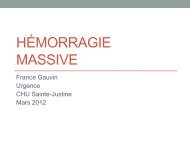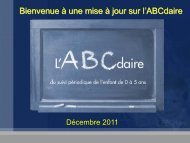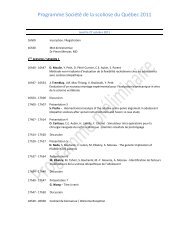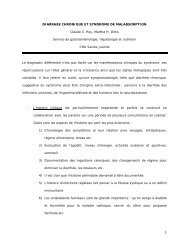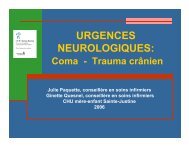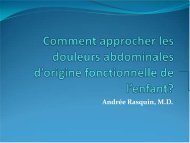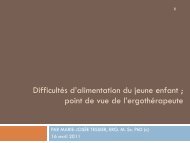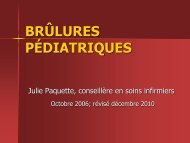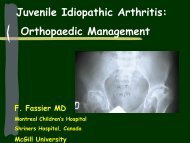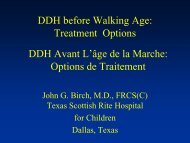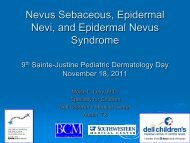Pelvic Osteotomies - CHU Sainte-Justine - SAAC
Pelvic Osteotomies - CHU Sainte-Justine - SAAC
Pelvic Osteotomies - CHU Sainte-Justine - SAAC
You also want an ePaper? Increase the reach of your titles
YUMPU automatically turns print PDFs into web optimized ePapers that Google loves.
PELVIC OSTEOTOMIES<br />
Where, When and How ?<br />
Reggie C. Hamdy ,MB, M.Sc., FRCS©<br />
25th <strong>Sainte</strong>-<strong>Justine</strong> Paediatric Orthopaedic Review Course<br />
March 8, 2012 Montreal, Quebec
<strong>Pelvic</strong> <strong>Osteotomies</strong><br />
• Rationale : why do we perform pelvic osteotomies ?<br />
• Radiological assessment of hip dysplasia<br />
• Types of pelvic ostetomies<br />
• Planning and surgical decision making : how to decide<br />
which type of pelvic ostetomy to perform
What are the consequences of untreated<br />
hip dysplasia ?<br />
About 75% of adult patients with end<br />
stage osteo-arthritis of the hip had an<br />
underlying hip pathology in their childhood<br />
Developmental dislocation of the hip<br />
Perthes disease<br />
Slipped capital femoral epiphysis.<br />
(Wedge 1978, Harris 1986)
Why does untreated Acetabular<br />
Dysplasia lead to OA ?<br />
Acetabular dysplasia leads to abnormal forces across the hip jpoint
<strong>Pelvic</strong> <strong>Osteotomies</strong><br />
<br />
Increase coverage of femoral head<br />
<br />
Normalize pressure across hip joint<br />
<br />
Prevent degenerative arthritis and<br />
obviate the need for arthroplasty<br />
at a relatively young age (Stulberg, Harris)
Therefore, <strong>Pelvic</strong> <strong>Osteotomies</strong> have a<br />
Central and Key role in the management of<br />
acetabular dysplasia by :<br />
* re-orienting or<br />
* reshaping or<br />
* augmenting the existing acetabulum<br />
in order to have a normal femoral head<br />
coverage
What type of pelvic and/or femoral<br />
osteotomy should be performed in<br />
order to restore the normal<br />
biomechanics of the hip joint?
Radiological assessment of hip<br />
dysplasia – depends on age<br />
• Ultrasound<br />
• Plain X-rays …. Gold standard<br />
• Arthrography<br />
• Ct scan (2D and 3D)<br />
• CT arthrography<br />
• MRI
Radiological assessment of hip<br />
• Acetabulum<br />
dysplasia<br />
• Proximal femur<br />
• Relation between acetabulum and proximal<br />
femur
Radiological Assessment<br />
C. Relation between proximal femur and<br />
acetabulum :<br />
1. Amount of femoral head uncoverage<br />
- Lateral coverage : Centre edge angle<br />
- Anterior coverage : False profile view<br />
2. Presence of subluxation :<br />
- Presence of subluxation : Shenton line<br />
- Abduction – internal rotation views of the hip
Relation between Acetabulum and femur
Radiological assessment of hip<br />
dysplasia<br />
1. Where is the pathology : in the acetabulum<br />
or proximal femur or both ?<br />
2. What is the exact pathology to be corrected ?
Where is the pathology : acetabulum<br />
or femur or both ?
What is the exact bony pathology ?<br />
• More than just malrotation or maldirection,<br />
acetabular dysplasia is a combination of :<br />
* acetabular maldirection,<br />
* margin erosion<br />
* torsion<br />
* hypoplasia (localized or global)<br />
* abnormal shape<br />
* decreased acetabular surface area<br />
J.Wedge, Editorial JPO 1997
In DDH : The key defect in the<br />
acetabulum<br />
ANTERO-LATERAL<br />
Therefore, any pelvic osteotomy<br />
planned has to address this deficiency
2 year F
Acetabular Dysplasia in Neuromuscular<br />
conditions<br />
• Global deficiency of the acetabulum<br />
• DO NOT DECREASE POSTERIOR<br />
COVERAGE
1 yr 8 mo 2 yrs 10 mo<br />
3 yrs 7 mo<br />
6 yrs 10 mo<br />
4 yrs 3 mo<br />
5 yrs
Planning for pelvic osteotomies<br />
1. Where is the pathology : acetabulum or femur ?<br />
2. What is the pathology to be corrected ?<br />
3. What type of osteotomy should be performed ?
How to increase femoral head coverage by<br />
pelvic osteotomies<br />
Change the orientation<br />
of the acetabulum<br />
Change the shape and size<br />
of the acetabulum<br />
Redirectional osteotomies<br />
Using extra-articular bone<br />
To augment the existing<br />
Acetabulum :Salvage procedures<br />
Comp 1 Salter.wmv<br />
Incomplete osteotomies<br />
Using articular cartilage<br />
Acetabuloplasties<br />
Increase antero-lateral<br />
Decrease posterior cov.<br />
No effect on volume<br />
Concentric reduction<br />
Increase antero-lateral coverage<br />
No effect on posterior cov.<br />
Increase volume of Acetabulum<br />
No concentric reduction required<br />
*Lateral Acet. (Dega)<br />
Global coverage<br />
*Pemberton (Antero-Lat)<br />
Increase Antero-late.cov
REDIRECTIONAL OSTEOTOMIES<br />
A. Salter innominate<br />
B. Double<br />
C. Triple osteotomies<br />
D. Spherical (Wagner 1, 2, 3)<br />
E. Peri-acetabular (Ganz)
SALTER OSTEOTOMY<br />
- Described by Robert Salter, Toronto 1961<br />
- Initially developed to correct the maldirected<br />
acetabulum in cases of DDH<br />
- Increases anterior and lateral coverage<br />
- Decreases posterior coverage,<br />
- Contra-indicated in neuromuscular conditions
PRE-REQUISITES OF<br />
SALTER OSTEOTOMY<br />
(and all Redirectional osteotomies)<br />
* Concentric reduction<br />
* Abduction at least 30°<br />
* Age: 18 months – 8 years (…. Adults)<br />
(difficult to perform after 8-10 years)
Operative Technique
Maneuvre to help open the osteotomy
AVERAGE IMPROVEMENT<br />
FOLLOWING SALTER<br />
- Acetabular index : 10°<br />
- Centre edge angle : 10°–15°<br />
OSTEOTOMY<br />
Therefore, Salter osteotomy is indicated for mild and<br />
moderate dysplasia
2 year F
KM 7+3 male 7-01
Can Salter osteotomy be performed<br />
in adolescents ?<br />
• YES<br />
• James McCarthy JBJS 1996
Outcome at Forty-five Years After Open Reduction<br />
and Innominate Osteotomy for Late-Presenting<br />
Developmental Dislocation of the Hip<br />
By Simon R. Thomas, MA, FRCS(Tr&Orth), John H. Wedge, MD,<br />
FRCS(C), and Robert B. Salter, MD, FRCS(C)<br />
J Bone Joint Surg (Am) 2007
Double Osteotomy (Sutherland JBJS 1977)
Triple osteotomies<br />
* Steel<br />
* LeCoeur<br />
* Carlioz<br />
* Tonnis<br />
Difference : ischial cut
Triple osteotomies : importance of the ischial cut
Workshop : Triple osteotomy
Maneuvre to help open the osteotomy in<br />
Salter procedure<br />
In Triple Osteotomy…. NO
<strong>Osteotomies</strong> that change the size<br />
and shape of the acetabulum<br />
A. ACETABULOPLASTIES<br />
Principle:<br />
Incomplete osteotomy of the ilium<br />
Restore a normal inclination of the acetabular roof by<br />
rotating cartilage-lined roof over the femoral head<br />
Types:<br />
A - Whole acetabular roof: DEGA(San Diego)<br />
B - Anterolateral part: PEMBERTON
ACETABULOPLASTIES<br />
Pre-requisite:<br />
Concentric reduction of the hip joint<br />
Age limit:<br />
Theoritically, until fusion of the tri-radiate cartilage<br />
(after fusion, cannot function anymore as a hinge)<br />
However, can be performed after skeletal maturity
Dega osteotomy (Wenger – San Diego)<br />
• Only the outer table of the ilium is cut<br />
• The inner table in intact and acts as a hinge<br />
• The cut extends to the sciatic notch
Workshop : Dega osteotomy
Residual Dysplasia after Closed reduction of DDH<br />
KG DOB 27-10-2001<br />
10-06-2003<br />
15-07-2005 26-3-2007
6 yrs 10 mo
Can we perform DEGA osteotomy after skeletal<br />
maturity ? YES<br />
Inan – Dabney<br />
Clin Orthop 2007
Does Dega osteotomy increase acetabular<br />
volume in developmental dysplasia of the<br />
hip?<br />
Ahmet Fevzi Ozgura et al , J Paediatr Ortho B, 2006<br />
Dega osteotomy increases the volume of the acetabulum
Pemberton Osteotomy
Pemberton ostetomy<br />
13 year anterior dislocation<br />
Gordon JBJS 1996
SHELF PROCEDURES<br />
Augmentation Procedures (not osteotomies)<br />
The main problem with the Shelf procedure<br />
is that - in some cases - there is resorption<br />
of the grafted bone that forms the shelf.
Workshop Shelf : Dr. W.MacKenzie
Shelf Procedure<br />
2005-06-16<br />
2007-03-27_2
CHIARI OSTEOTOMY<br />
* Femoral head is covered with fibrous capsular<br />
tissue - fibrocartilage (not hyaline cartilage)<br />
* Non-concentric and incongruent hips,<br />
subluxated and even dislocated hips<br />
Biomechanical Advantage of Chiari Osteotomy:<br />
Medial displacement of the hip joint
Chiari osteotomy
Planning for pelvic osteotomies<br />
1. Where is the pathology : acetabulum or femur ?<br />
2. What is the pathology to be corrected ?<br />
3. What type of osteotomy should be performed ?
THANK YOU !
Perthes : Very large head – normal acetabulum
18 y/o, pre-op<br />
progressive pain L hip<br />
Post PAO/PFO<br />
Clohisy JC, Schoenecker PL, et.<br />
al. Periacetabular osteotomy for<br />
Tx of acetab dysplasia assoc w/<br />
major aspherical femoral head<br />
deformities JBJS-A 89,<br />
2007:1417-23<br />
20+8 ~3 yrs post-op pain resolved
14 y MED JB<br />
Chiari Osteotomy
PELVIC OSTEOTOMIES<br />
I.<strong>Osteotomies</strong> that use bone to increase<br />
coverage of the femoral head:<br />
Shelf procedures<br />
Chiari osteotomy<br />
These two osteotomies (Shelf and Chiari) are<br />
often referred to as salvage procedures<br />
because bone and not articular cartilage is used<br />
to increase coverage of the femoral head.
What is the natural history of hip<br />
subluxation<br />
• Is the subluxation progressive<br />
In most cases …. YES
1 yr 8 mo 2 yrs 10 mo<br />
3 yrs 7 mo<br />
6 yrs 10 mo<br />
4 yrs 3 mo<br />
5 yrs
Residual Dysplasia after Closed reduction of DDH<br />
KG DOB 27-10-2001<br />
10-06-2003<br />
15-07-2005 26-3-2007
REDIRECTIONAL OSTEOTOMIES<br />
A. Salter innominate<br />
B. Double and triple osteotomies<br />
C. Spherical (Wagner 1, 2, 3)<br />
D. Peri-acetabular (Ganz)
Gigli saw + silk suture<br />
Lewin clamp
II. OSTEOTOMIES THAT USE ACETABULAR<br />
CARTILAGE TO INCREASE COVERAGE OF<br />
THE FEMORAL HEAD<br />
1. Acetabuloplasties (Dega and Pemberton)<br />
Acetabular roof is mobilized and<br />
turned down to normal inclination<br />
2. Redirectional osteotomies<br />
Salter, Double, Triple, Spherical<br />
(Wagner 1, 2, 3) and Peri-acetabular<br />
(Ganz)
3 years old
Maldirected acetabulum Capacious acetabulum Lateralized acetabulum<br />
2005-06-16_5
WHAT IS THE EXACT PATHOLOGY<br />
THAT NEEDS TO BE CORRECTED?<br />
A. If the acetabulum is affected, what is it<br />
exactly that needs to be corrected?<br />
Is it a:<br />
maldirected acetabulum<br />
a globally deficient acetabulum<br />
a deficiency of the anterior or of the<br />
posterior walls<br />
a small acetabulum with a big femoral<br />
head
Radiological assessment of hip<br />
dysplasia<br />
• Ultrasound<br />
• Plain X-rays<br />
• Arthrography<br />
• Ct scan (2D and 3D)<br />
• CT arthrography<br />
• MRI
2005-06-16<br />
2006-12-01 2007-03-27_2
J.Wedge, Editorial JPO 1997<br />
• More than just malrotation or maldirection,<br />
acetabular dysplasia is a combination of :<br />
* acetabular maldirection,<br />
* margin erosion<br />
* torsion<br />
* hypoplasia (localized or global)<br />
* abnormal shape<br />
* decreased acetabular surface area
Chiari : wrong operation
<strong>Pelvic</strong> <strong>Osteotomies</strong><br />
• Rationale : why do we perform pelvic osteotomies ?<br />
• Pre-operative assessment<br />
• Types of pelvic ostetomies<br />
• Hip dysplasia : classification<br />
• Radiological assessment of hip dysplasia<br />
• Planning and surgical decision making : how to decide<br />
which type of pelvic ostetomy to perform
PERI-ACETABULAR<br />
OSTEOTOMY<br />
A. Reinhold Ganz, Berne, Switzerland<br />
B. Combines advantages of both triple and<br />
spherical osteotomies<br />
C. Unlike triple, maintains posterior<br />
acetabular column with minimal<br />
deformation of the pelvis<br />
D. Like spherical, can rotate the acetabular<br />
fragment to correct any degree of<br />
acetabular dysplasia
KEY RADIOGRAPHIC LINES<br />
(Immature Skeleton)<br />
• Hilgenreiner’s line<br />
• Perkin’s line
ACETABULAR INDEX OF<br />
HILGENREINER<br />
Normal Values<br />
New Born - 28°<br />
At age 2 - 20°<br />
Good indicator of acetabular dysplasia
KEY RADIOGRAPHIC LINES<br />
(Immature Skeleton)<br />
• Hilgenreiner’s line<br />
• Perkin’s line
ACETABULAR INDEX OF<br />
HILGENREINER<br />
Normal Values<br />
New Born - 28°<br />
At age 2 - 20°<br />
Good indicator of acetabular dysplasia
KEY RADIOGRAPHIC<br />
LANDMARKS<br />
(Mature Skeleton)<br />
• Sharp’s acetabular angle<br />
• Upper normal limit = 43
CE ANGLE OF WIBERG<br />
Normal Values<br />
5-8 y. 25°<br />
9-12 y 30°<br />
>13 y. 35°<br />
Assess the lateral<br />
coverage of the femoral head
ANGLE OF LEQUESNE<br />
AND DE SEZE<br />
Classification<br />
Degrees<br />
Normal 25°<br />
Mild dysplasia 21°-21°<br />
Severe dysplasia
Workshop : Salter osteotomy
KK 5+4 female Untreated DDH 7-96
7-96 8-96<br />
S/P bilateral staged open reductions and<br />
Salter osteotomies plus shelf on the left hip
The anterior centre- edge angle<br />
was termed VCA by Lequesne<br />
and de Seze.1 The angle is composed<br />
of a vertical line through<br />
the centre of the femoral head<br />
(line VC) and a second line<br />
through the centre of the hip and<br />
the foremost aspect of the acetabulum
Is the Acetabulum excessively<br />
anteverted in DDH ?<br />
• Salter 1961…… Yes<br />
• Wenger 1997 …NO<br />
– Maldirected acetabulum is only one of the<br />
deformities present in DDH<br />
– It does not occur in all cases
14+0 F, B DDH. L hip lateral fatigue pain



